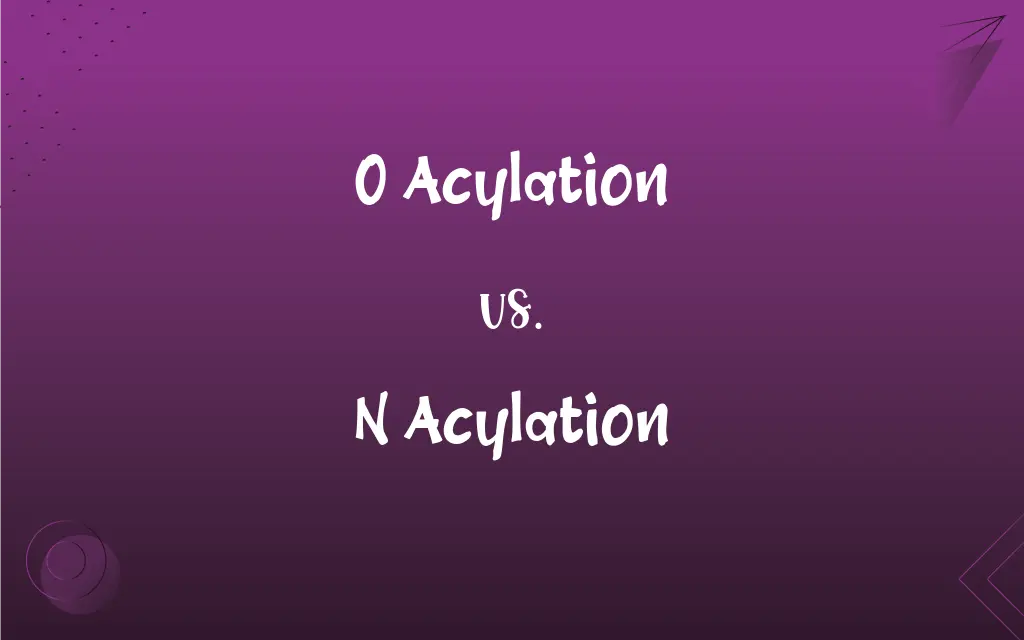O Acylation vs. N Acylation: What's the Difference?
Edited by Aimie Carlson || By Harlon Moss || Published on April 14, 2024
O-acylation involves the attachment of an acyl group to an oxygen atom, while N-acylation involves the attachment to a nitrogen atom.

Key Differences
O-acylation and N-acylation are both processes involving the addition of an acyl group to a molecule, but they differ in the atom to which the acyl group is attached. O-acylation refers to the attachment of an acyl group to an oxygen atom within a molecule. This process is common in the formation of esters, where a carbon-oxygen double bond is formed. N-acylation, on the other hand, involves the attachment of an acyl group to a nitrogen atom. This reaction is key in the formation of amides, where a carbon-nitrogen double bond is created. N-acylation plays a vital role in the synthesis of proteins and peptides, as well as in the modification of amines.
The difference in the reactive site—oxygen for O-acylation and nitrogen for N-acylation—leads to differences in the chemical properties and reactivity of the resulting compounds. O-acylated products, such as esters, are often used as solvents, flavors, and fragrances, owing to their stability and desirable chemical properties. N-acylated products, like amides, are found in nature as proteins and are synthetically valuable in creating polymers and pharmaceuticals.
The choice between O-acylation and N-acylation depends on the desired chemical product and its intended use. O-acylation is favored when synthesizing esters from carboxylic acids and alcohols, a reaction that is often catalyzed by acid or base. N-acylation is preferred for creating amides from carboxylic acids and amines, a process that may require activating agents or catalysts to facilitate the reaction.
Both O-acylation and N-acylation involve the formation of carbon-oxygen and carbon-nitrogen bonds respectively, they are distinguished by their reaction sites and the types of compounds they produce. These differences have significant implications for their applications in organic synthesis, pharmaceuticals, and material science.
Comparison Chart
Reactive Atom
Oxygen
Nitrogen
ADVERTISEMENT
Product Type
Esters
Amides
Common Uses
Solvents, flavors, fragrances
Proteins, polymers, pharmaceuticals
Reaction Conditions
Often requires acid or base catalysis
May require activating agents or catalysts
Chemical Properties
Generally stable, with desirable solvent properties
Important in biological functions, stable under many conditions
O Acylation and N Acylation Definitions
O Acylation
Producing esters by connecting an acyl group to oxygen.
O-acylation of alcohols leads to versatile esters in organic chemistry.
ADVERTISEMENT
N Acylation
Utilizing N-acylation in drug development.
N-Acylation improves drug properties by modifying amine groups.
O Acylation
The need for catalysts in facilitating O-acylation.
Acid catalysts significantly increase the efficiency of O-acylation reactions.
N Acylation
Creating amides by N-acylation.
Protein synthesis involves N-acylation to form amide bonds between amino acids.
O Acylation
The addition of an acyl group to an oxygen atom.
Esterification via O-acylation is a fundamental step in fragrance synthesis.
N Acylation
The role of catalysts in N-acylation.
Catalysts are often required to achieve efficient N-acylation in organic synthesis.
O Acylation
A method for modifying chemical structures in synthesis.
O-acylation is crucial for modifying the oxygen-containing sites of molecules.
N Acylation
Protecting amines through N-acylation during complex syntheses.
N-Acylation can serve as a protective strategy for amines in multi-step reactions.
O Acylation
Using O-acylation to protect hydroxyl groups during synthesis.
The O-acylation of a hydroxyl group protects it from unwanted reactions.
N Acylation
The attachment of an acyl group to a nitrogen atom.
N-Acylation of amines is a key step in synthesizing amide bonds in drugs.
FAQs
How does O-acylation differ from N-acylation in products formed?
O-acylation typically forms esters, while N-acylation forms amides.
What is O-acylation?
The addition of an acyl group to an oxygen atom in a molecule.
What is N-acylation?
The attachment of an acyl group to a nitrogen atom in a molecule.
What are the common uses of N-acylated compounds?
They are critical in pharmaceuticals, polymers, and biological functions.
What are the common uses of O-acylated compounds?
They are often used as solvents, flavors, and fragrances.
Which catalysts are used in O-acylation?
Acid or base catalysts are commonly used in O-acylation reactions.
Which catalysts are used in N-acylation?
Activating agents or catalysts are necessary for efficient N-acylation.
What role does O-acylation play in organic synthesis?
It is crucial for modifying oxygen-containing compounds and forming esters.
Can N-acylation be used to protect amine groups?
Yes, N-acylation can protect amine groups in complex syntheses.
Can O-acylation be used to protect hydroxyl groups?
Yes, O-acylation is a strategy to protect hydroxyl groups during synthesis.
How does the choice of acylating agent affect O-acylation?
The efficiency and selectivity of O-acylation depend on the acylating agent used.
How does the choice of acylating agent affect N-acylation?
Similar to O-acylation, the choice influences the efficiency and outcome of N-acylation.
Why is N-acylation important in pharmaceutical chemistry?
It allows for the modification of drug molecules to improve properties.
Can both O-acylation and N-acylation occur in the same molecule?
Yes, if the molecule contains both hydroxyl and amine groups, both reactions can be targeted.
What are the environmental implications of O-acylation?
The solvents and byproducts of O-acylation can impact environmental sustainability.
What are the environmental implications of N-acylation?
Like O-acylation, the choice of solvents and waste management are important considerations.
Is O-acylation reversible?
O-acylation can be reversible under certain conditions, allowing for ester hydrolysis.
Is N-acylation reversible?
N-acylation is generally less reversible than O-acylation, especially in biological systems.
What role does N-acylation play in organic synthesis?
It is vital for amide bond formation and amine modification.
How are reaction conditions different between O-acylation and N-acylation?
O-acylation often requires different catalytic conditions compared to N-acylation.
About Author
Written by
Harlon MossHarlon is a seasoned quality moderator and accomplished content writer for Difference Wiki. An alumnus of the prestigious University of California, he earned his degree in Computer Science. Leveraging his academic background, Harlon brings a meticulous and informed perspective to his work, ensuring content accuracy and excellence.
Edited by
Aimie CarlsonAimie Carlson, holding a master's degree in English literature, is a fervent English language enthusiast. She lends her writing talents to Difference Wiki, a prominent website that specializes in comparisons, offering readers insightful analyses that both captivate and inform.































































